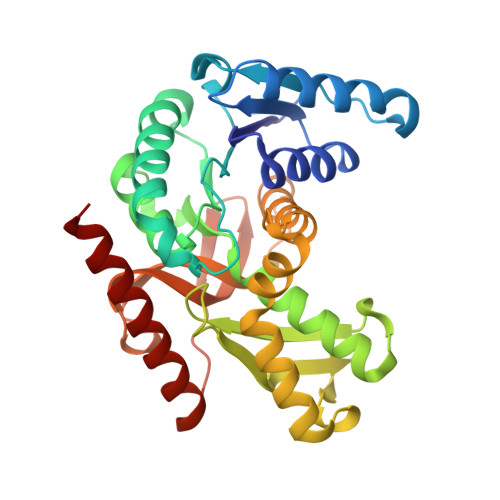Large Improvement in the Thermal Stability of a Tetrameric Malate Dehydrogenase by Single Point Mutations at the Dimer-Dimer Interface.
Bjork, A., Dalhus, B., Mantzilas, D., Sirevag, R., Eijsink, V.G.H.(2004) J Mol Biol 341: 1215
- PubMed: 15321717
- DOI: https://doi.org/10.1016/j.jmb.2004.06.079
- Primary Citation of Related Structures:
1UXG, 1UXH, 1UXI, 1UXJ, 1UXK - PubMed Abstract:
The stability of tetrameric malate dehydrogenase from the green phototrophic bacterium Chloroflexus aurantiacus (CaMDH) is at least in part determined by electrostatic interactions at the dimer-dimer interface. Since previous studies had indicated that the thermal stability of CaMDH becomes lower with increasing pH, attempts were made to increase the stability by removal of (excess) negative charge at the dimer-dimer interface. Mutation of Glu165 to Gln or Lys yielded a dramatic increase in thermal stability at pH 7.5 (+23.6 -- + 23.9 degrees C increase in apparent t(m)) and a more moderate increase at pH 4.4 (+4.6 -- + 5.4 degrees C). The drastically increased stability at neutral pH was achieved without forfeiture of catalytic performance at low temperatures. The crystal structures of the two mutants showed only minor structural changes close to the mutated residues, and indicated that the observed stability effects are solely due to subtle changes in the complex network of electrostatic interactions in the dimer-dimer interface. Both mutations reduced the concentration dependency of thermal stability, suggesting that the oligomeric structure had been reinforced. Interestingly, the two mutations had similar effects on stability, despite the charge difference between the introduced side-chains. Together with the loss of concentration dependency, this may indicate that both E165Q and E165K stabilize CaMDH to such an extent that disruption of the inter-dimer electrostatic network around residue 165 no longer limits kinetic thermal stability.
Organizational Affiliation:
Department of Molecular Biosciences, University of Oslo, P.O. Box 1041, Blindern, N-0316 Oslo, Norway. [email protected]
















